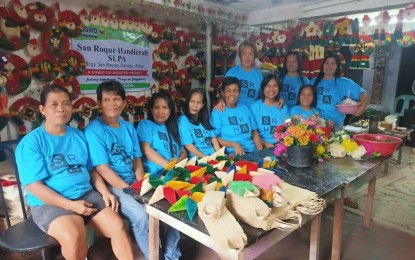
FESTIVE ORNAMENTS. Members of the San Roque Handicraft Association display their festive abaca handicrafts in time for the holidays. Established in 2016, the association was given start-up capital by the Department of Social Welfare and Development through its Sustainable Livelihood Program to produce abaca-derived products. (Photo courtesy of Violeta Lorilla)
DARAGA, Albay – For a group of women handicraft makers in Albay town, Christmas starts in July. Like Santa's tinkering elves tirelessly working round-the-clock all year round, these women craft their holiday magic months before the festive season begins.
Turning passion into profit
In the humble abode of Violeta Lorilla in San Roque village, Daraga town, all that's left of her handmade holiday masterpieces are a handful of miniature tabletop Christmas trees set on a wooden base and some abaca wreaths in festive hues waiting to be assembled.
"I have run out of stocks," Lorilla said, attributing her early sell-out to the November rush.
As a handicraft maker who operates on a per-order basis, Lorilla bared that the start of "ber" months in the Philippines usually ushers in an uptick in the demand for abaca ornaments, further peaking in the ensuing months leading up to the holiday season.
Maribeth Yasis, 36, who specializes in making abaca lanterns and flower ornaments, said handicraft makers set their sights on producing abaca decor as early as possible for economic and practical reasons --to get a headstart on the holiday rush and ensure they have enough time to produce native ornaments that are a product of meticulous craftsmanship.
"My husband and I started making the star lanterns in July so we could accommodate the bulk orders from our customers, who also resell our products," she said.
For her holiday hustle, Yasis bared that she earned at least PHP20,000 which she intends to use as added capital for her thriving business.
However, much as she wants to replenish her stocks before the holidays, the mother of two revealed that crafting intricate ornaments requires time and manpower.
Yasis, who learned the craft from her mother, said the typical process of making an abaca star lantern is time-consuming —from gathering the abaca fiber to designing a pattern, building a frame, cutting, adding embellishments, dyeing, drying, trimming excess fibers for that finishing touch and finally performing a quality check to meet quality standards, each festive ornament is a product of hard manual labor.
Because handicraft making involves such a tedious process, Mercy Fulo, 55, said one must not only be "skillful" but must also be "very patient”.
"Unlike in the past, business has been very good this year," Fulo said.
Fulo estimates selling over 10,000 poinsettia flowers made from sinamay, a fabric made from abaca fibers.
Since her products are also used by other craft makers in her village to design more ornate pieces such as wreaths and other wall and tabletop decor, she started making the flowers in her spare time as early as February.
Fulo said her PHP30,000 earnings for her holiday grind are "a big help" to augment the family's needs, especially now that Christmas is just around the corner.
Asked for their Christmas wishlist, Yasis said she wants to have an abaca yarning machine so she can increase her production.
Fulo, on the other hand, said she wants to learn other livelihood skills because abaca handicraft making is "only seasonal."
With their exceptional craftsmanship, these women have turned their passion into profits, proving that skills, creativity and commitment are valuable resources during the holidays.
The sisterhood
Lorilla, Yasis and Fulo are members of the San Roque Handicraft Association (SRHA), a group of women handicraft makers who were given start-up capital by the Department of Social Welfare and Development through its Sustainable Livelihood Program (SLP) to produce abaca-derived products.
Established in 2016, the association's members are all beneficiaries of the Pantawid Pamilyang Pilipino Program.
Yasis said the association has greatly helped them grow their businesses by providing myriad opportunities to showcase their products through local bazaars and other promotional activities.
Aside from alleviating their socio-economic conditions, she further said it has also preserved the culture and tradition of handicraft making in San Roque village in Daraga town.
More than economic benefits, however, it is the strong bond that the members have forged over the years that makes the association even more remarkable, according to Fulo.
Interestingly, in their close-knit sisterhood, each artisan creates distinct handmade crafts. From sturdy food covers to wine bags, angel tree toppers, flower accents, vegetable and fruit hanging decor, wreaths, and other festive ornaments, they elevate their shared passion for handicraft making into a business venture that they can all benefit from.
As Filipinos scramble for their last-minute holiday shopping frenzy, the women of SRHA have one plea: support local products.
It will sustain the livelihoods of local artisans and preserve the culture and tradition of abaca handicraft making that Albay is known for. (PNA)
